Top Houseplant Picks for Your Light Level
Looking for a new plant to brighten your home or office? As a new or novice indoor gardener, you may have noticed that the amount of information available online can be immense, complex, and even contradictory. This is fine if you have hours and hours to research the perfect plant for your space, but if not, you may be stuck in a frustrating jungle of varieties and details, unable to move on to actually enjoying your new plant!
Don't worry, and don't give up just yet! We're here to help. One of the most important factors to consider when buying a new houseplant is matching the light requirements of a plant to the light availability of your space. We've made it simple, and outlined some of the best plants by light level below. These plant picks are some of the easiest to grow, most popular, and readily available plants on the market today!
LOW LIGHT
Tolerant Houseplants
This includes office spaces or bedrooms with few or no windows. These green machines can work wonders on an otherwise sterile space, and may suffer in direct sunlight.
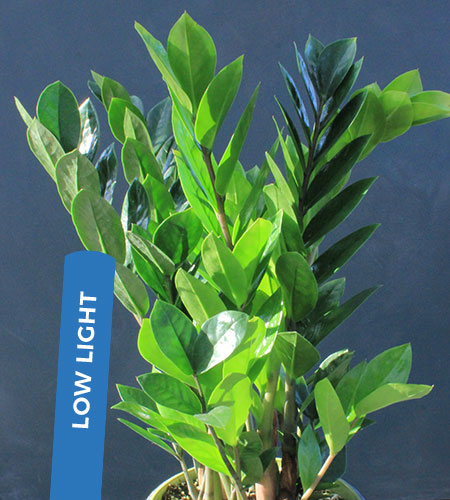
Zamioculcas zamiifolia
Common Names: ZZ Plant or False Zamia
This plant is uncommon in that it can tolerate full sun to nearly full shade, so it is very easy to place in almost any home, and is also extremely drought-resistant. The one thing Zamioculcas cannot stand is overwatering. Always be sure that the soil of this plant is well-draining, and nearly or completely dry from top to bottom before giving it a thorough watering. This can take weeks, depending on lighting conditions and temperatures. False Zamia is hardy down to 40F, making it ideal for cooler rooms.
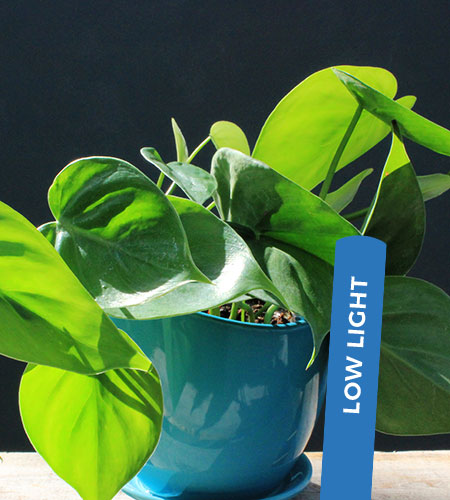
Philodendron cordatum
Common Name: Heartleaf Philodendron
This is a great option for someone who doesn’t have a lot of surface area. As a trailing/vining plant, it does well hanging from the ceiling, or perched somewhere high up. Care for this plant is relatively minimal- Let soil dry several inches down from the top before watering thoroughly. While this plant prefers bright indirect light, it will tolerate full shade. Cuttings root easily in water! Philodendron is also known for being a great Air Purifier.
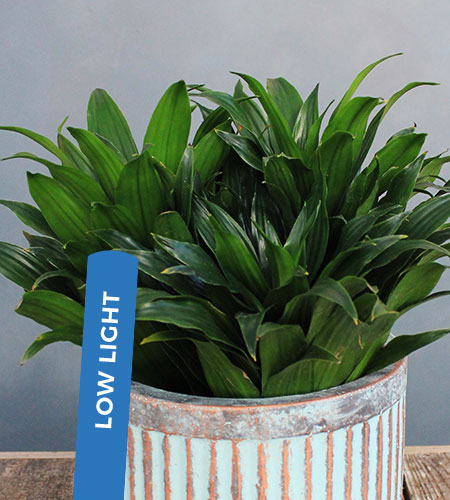
Dracaena Jc compacta
Common Name: Janet Craig Dracaena.
One of the lowest light and most drought tolerant plants we carry. Let soil dry about halfway down from the top before watering thoroughly. In a dim area this can take weeks, making this plant extremely low-maintenance. This plant can be grown in an area with only artificial lighting, although it prefers natural light. As it grows it develops a bare, woody cane at the bottom, while maintaining a compact head of foliage at the top of each stalk. While very slow growing, this plant will eventually reward you with heights of about 4-7 ft.
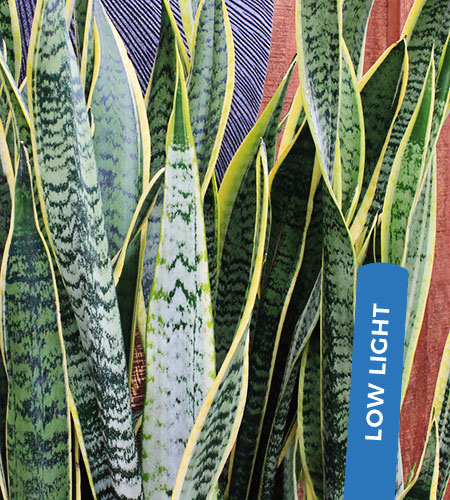
Sansevieria
Common Names: Snake Plant or
Mother in Law’s Tongue
This plant, like the ZZ mentioned above, has the unusual ability to tolerate high or low light conditions. Its extreme drought tolerance makes it an ideal picl for anyone who travels a lot. Soil should be dry from the top to the bottom, before providing the plant with a very thorough drink of water. When in direct light, check soil every 10 – 14 days. If soil is still moist, wait longer. When in indirect light/ shade, check soil for dryness every 14 days or more. Make sure that the soil is drying completely, even if it takes a lot longer than the recommended timeframe. Plant your Sansevieria into a sandy, gritty soil mix, and try to select a pot with drainage holes in the bottom, as they cannot stand wet feet. Snake plant is reported to be a good choice if you’re looking for an air purifier.
MEDIUM LIGHT
Tolerant Houseplants
These plants make great additions to most average spaces that receive some natural light, either indirect or direct. Keep in mind: the more light, the faster many of these will grow.
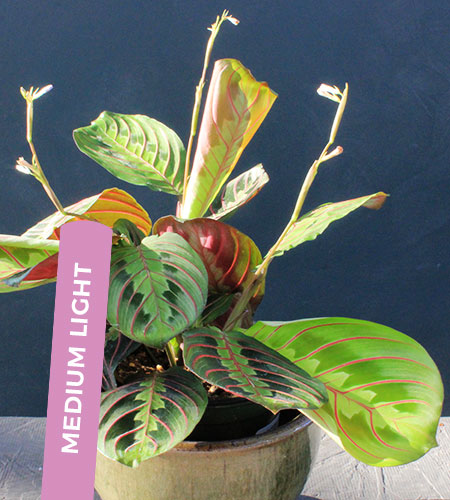
Maranta
Common Name: Prayer Plant
This sprawling groundcover is perfect if you’re looking for a plant that will not get terribly tall, or something that has a little color and pattern. Preferably this plant should receive morning or dappled afternoon light. Prayer Plant tends to grow faster and have better color with partial direct sun during the day. However, it also grows happily in bright, indirect light. When in less light, Maranta usually requires less water. This plant likes to stay just slightly moist. When in sun, check soil moisture 2-3 times weekly. When in indirect light, check soil moisture 1-2 times weekly. When ready, water plant thoroughly. Prayer plant is Non-toxic to cats and dogs, making it a good choice for pet owners.
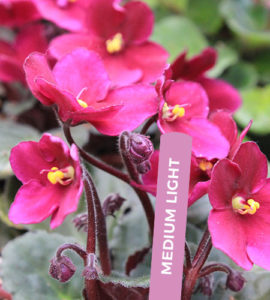 Saintpaulia
Saintpaulia
Common Name: African Violet
This compact flowering plant is a great way to add a pop of color to an interior space. To flower to its fullest potential, African Violet should receive some direct sun during the day, whether it be morning, or dappled afternoon sun. Full, direct afternoon (Western) light, or all day Southern light can burn this plant, especially during the summer months. Saintpaulia can grow in a bright, indirect light but it can decrease flower production slightly. African Violets prefer to be kept just slightly moist. Watering is best done by soaking the plant from the bottom, as they are susceptible to crown rot when water is poured in from the top. Fertilizing regularly also helps to encourage African Violets to bloom again. African Violets are another good selection for pet owners, as they are non-toxic to Cats and Dogs.
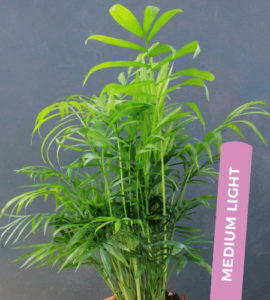 Chamaedorea ‘neanthe bella’
Chamaedorea ‘neanthe bella’
Common Name: Parlor Palm
This plant’s compact form, which has a maximum size of roughly 4’x4’, makes it an ideal long-term houseplant. (Unlike its relatives, some of which can reach 20’+ over time.) Neanthe Bella prefers to have some direct sunlight during the day, either in the morning or the afternoon. It will tolerate a bright, indirect light, but will grow more slowly and use water less quickly. Water your Parlor Palm thoroughly when the soil surface dries, but do not allow the soil to dry out completely. Depending on current weather, household temperature, container size, etc., watering needs can fluctuate. Check soil moisture 1-3 times weekly and water when needed. Consistently humid conditions are required to keep this palm at its best. Humidifiers, humidity trays, or constant misting are ways to provide ample moisture to the area around your plant. Browning fronds and spider mites infestations are likely if left in arid surroundings. In addition to being Cat and Dog safe, it is also an excellent air purifier.
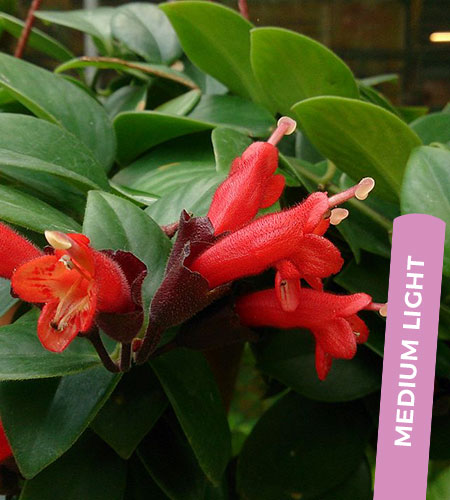
Aeschynanthus
Common Name: Lipstick Plant
This trailing plant boasts beautiful red flowers off and on throughout the year. Flower production for Lipstick Plants will be at its best when in some direct sun, either part morning or dappled afternoon light. Fertilizing regularly (At least every 2 months or so.) also promotes blooms. Let the soil on this plant dry partially in-between waterings. Check moisture levels in the soil from 1-3 times per week, depending on home temperatures, current weather, pot size, etc. Hanging branches can reach 3’ or more. Cut back to desired size if it gets overgrown. (Try to time this soon after a flowering) Aeschynanthus is non-toxic to both Cats and Dogs.
HIGH LIGHT
Tolerant Houseplants
In our Seattle climate, most of these plants need direct or bright indirect light from a sunny window, and may even benefit from a grow light in the rainy season.
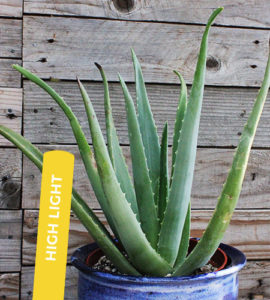 Aloe vera
Aloe vera
Alternate name: Medicine Plant
A plant so named for it's many beneficial uses! Place your Aloe vera in an area that will receive unobstructed direct sun for at least the entire morning or afternoon, if not all day Southern sun. If placed in indirect light, it is much easier to overwater your plant, and growth will most likely become spindly and stretched. Aloe is very drought tolerant and so makes for a very low-maintenance houseplant. Allow soil to dry completely before watering. The timeframe on when you should water can vary greatly depending on multiple factors including container size, current weather, home temperatures, wind flow, and others. Roughly, somewhere between every 7-10 days in the summer time, and every 14 or so in the winter when light is limited. Make sure you feel into the soil to ensure that it is dry before you water. If still moist, even after the 14 day mark, wait longer. When soil is finally dry, water very thoroughly. If your space has very limited light during winter, you can add a grow light to the space to supplement your natural sun exposure. Aloe vera plants do not want to have wet feet! Make sure the container you choose has a drainage hole, and that you plant into Cactus Mix Potting Soil. Aloe vera is also known for being an excellent air purifier.
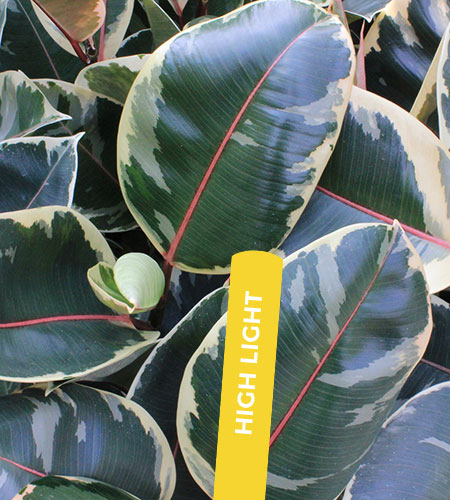
Ficus elastica
Common Name: Rubber Plant
Either morning or afternoon sun works well for this plant. Allow the Rubber Tree’s soil to dry partially in-between watering. Check the soil for dryness 1-2 times weekly; making sure the soil is dry at least an inch or two down from the soil surface, then water thoroughly. Ficus elasticsa likes high humidity. Regular misting, a humidifier, or a pebble tray placed below the plant can help to provide that. They can live without excess humidity but are much more likely to contract a spider mite infestation when left in arid conditions. Rubber plants are reported to be a great choice if air purification is your goal. While the Rubber Plant can reach upwards of 7’ or 8’ tall, regular pruning can help to keep it more appropriately sized for interior spaces.
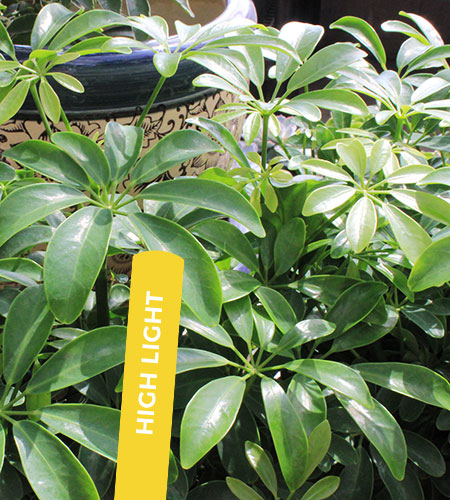
Schefflera arboricola
Common Name: Umbrella Tree
This is a great choice for anyone looking for a large statement plant. Schefflera can generally reach from 10’ to 15’ in height, but with yearly pruning they can be kept to a more manageable size. Full morning or afternoon sun is best for this plant. Umbrella plants are relatively drought tolerant, wanting their soil to dry about ¼ of the way down from the surface before you water thoroughly. Check moisture levels in the soil 1-2 times weekly, although with larger specimens once a week is often more than enough. Schefflera appreciate higher humidity levels, so misting or otherwise providing some moisture to the air is helpful in keeping it looking its best.
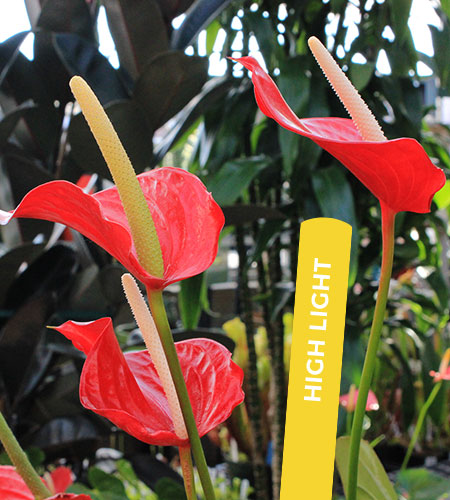
Anthurium
Common Name: Flamingo Flower
This plant does best in either full morning or partial afternoon sun. Keep an eye on it during the height of summer if it is in afternoon or full Southern exposure as they can burn when given too much direct light. It will tolerate a bright, indirect sunlight but this will likely slow flower production considerably. Anthurium wants to dry slightly in-between watering. 1-2 times weekly is usually plenty. Wait until soil is dry by about ½ to 1 inch down from the soil surface, and then water thoroughly. Flowers typically last for 3-4 months before they start to discolor and fade. This is often long enough for the plant to produce one or more flowers that will come up to replace the fading ones, keeping it in flower for most of the year.
So, there you have it! 12 beautiful and high-performing plants that will help brighten any space, no matter what sort of lighting you have! If you have any more questions, do not hesitate to give us a call. We're always here to offer advice and expertise, so that every gardening endeavor is nothing short of a success!
Written by Kate Convey, Indoor Plant Manager and Buyer
Edited By Sarah Oakes and C. Song
